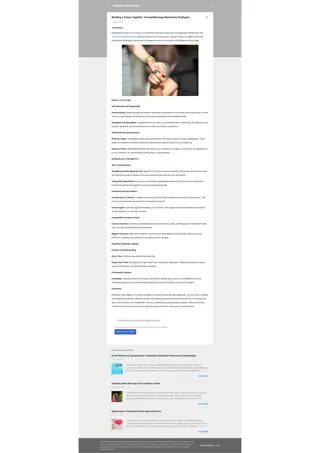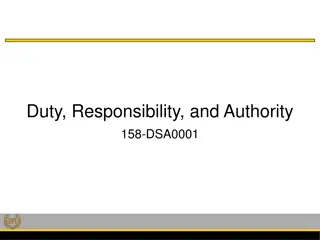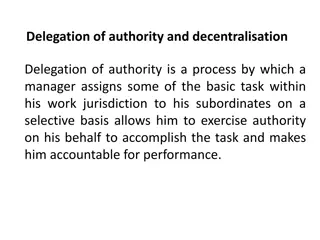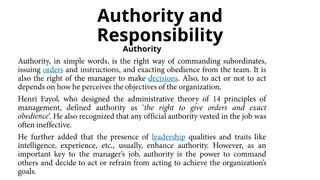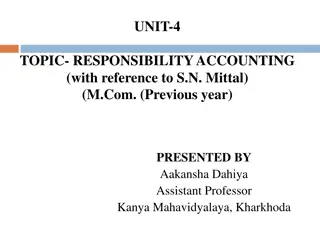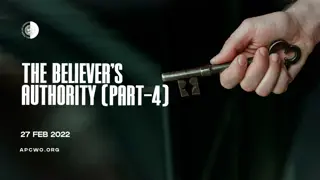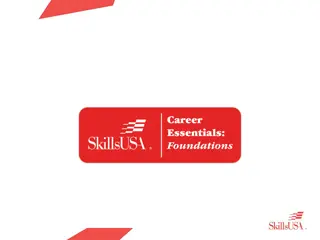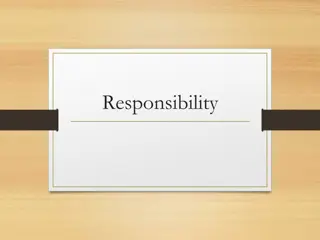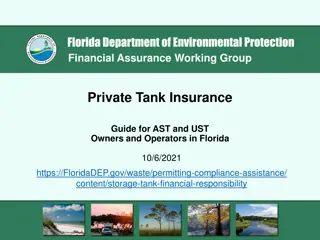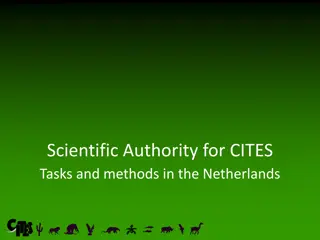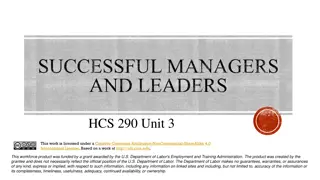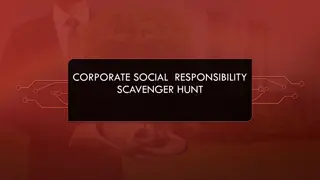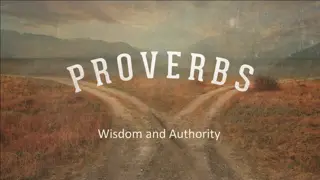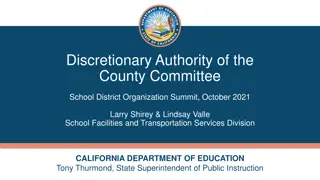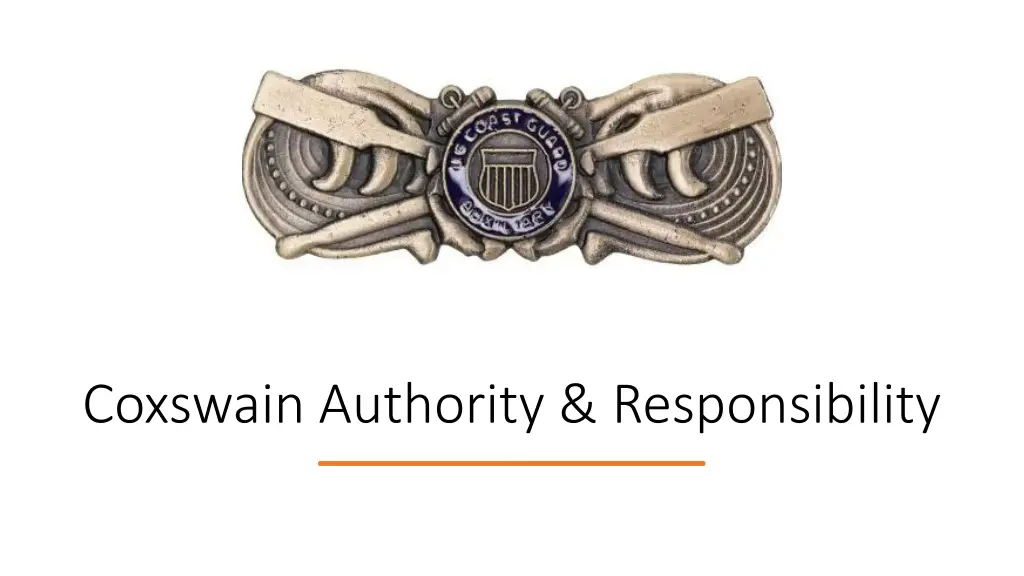
Coxswain Authority and Responsibility
Learn about the authority and responsibilities of a coxswain, including safety and conduct priorities, assistance to the Coast Guard, firefighting policies, salvage operations guidelines, and more based on relevant regulations.
Download Presentation

Please find below an Image/Link to download the presentation.
The content on the website is provided AS IS for your information and personal use only. It may not be sold, licensed, or shared on other websites without obtaining consent from the author. If you encounter any issues during the download, it is possible that the publisher has removed the file from their server.
You are allowed to download the files provided on this website for personal or commercial use, subject to the condition that they are used lawfully. All files are the property of their respective owners.
The content on the website is provided AS IS for your information and personal use only. It may not be sold, licensed, or shared on other websites without obtaining consent from the author.
E N D
Presentation Transcript
In Order of Precedence Coxswain Authority & Responsibility 1. Safety & Conduct of passengers of crew. 2. Safe Operation & Navigation of the boat assigned. 3. Completion of the sortie or mission. Ref. CIM 5000.3 (series)CH.5 Part 1 (5-1-8)
In accordance with (IAW) 14 USC 822 to assist Coast Guard: 1. Promote safety and effect rescues. 2. Promote efficient operation of motorboats & yachts. 3. Foster knowledge of compliance w/laws, rules & regulations. 4. Facilitate other operations for Coast Guard. Coast Guard Auxiliary Purpose Ref. CIM 5000.3 (series) CH1 Part 4 (1-4-2)
Independent firefighting. CG personnel shall not engage in independent fire fighting operations, except to save a life or in the early stages of a fire to avert a significant threat without undue risk. Fire Fighting Policy Task COXN 03-03-Aux Commercial vessels & waterfront facilities. CG personnel shall not actively engage in fire fighting except in support of a regular firefighting agency under the supervision of a qualified fire officer. Ref. (IAMSAR) CIM 16130.2(series)(4.4.2.2)
CG Units may assist within capabilities, if salvor requests. When no commercial salvage facilities are on scene, CG units should only engage (e.g. ungrounding, pumping, damage control) to prevent a worsening situation. General Salvage Other than Towing Task COXN 03-03-Aux Any salvage operations shall be performed at the discretion of the unit CO/OINC. CG units & personnel shall not be unduly hazarded in performing salvage. Ref (IAMSAR) CIM 16130.2 (series) (4.3.1)
Occasionally an operator will insist that the CG act, such as ungrounding their vessel. CG is under no obligation. If a decision to comply with such request it should be made clear that the operator is assuming the risk of the operation. The fact that the action is undertaken at operator s request, and is against CG advice, should be logged. Operator Insistence Task COXN 09-03-Aux Ref. (IAMSAR) CIM 16130.2 (series) (4.3.3)
Maximum Underway (Fatigue) Hours) Underway Limits Task COXN 02-01-Aux Boat Size Seas <4 FT Seas > 4 FT Rest Hours Required 30 FT & above 8 hours 8 hours 8 hours Less Than 30 FT 8 hours 0 8 hours PWC no seas greater than 3 FT 6 hours N/A 1 hour required after 3 hrs Trailering 350 miles (total) or 8 hours Ref. AOPG Vol 1 CH10 (Sec L.6.) Table 10-3
Trailering hours shall be counted towards crew fatigue limitations for boat crews. (For fatigue standards, 1 hour of trailering counts as 30 minutes towards crew fatigue computation). Trailering for any Auxiliary activity under orders shall not exceed 350 miles (total) or 8 hours in a 24-hour period. (Fatigue) Hours Trailering Ref. AOPG Vol 1 CH10 (Sec L.6.)
Fatigued personnel may not realize when their physical or metal state is compromised. Decreased coordination Narrow attention span Lower standard of performance Judgement errors in boat handling, seamanship, mission decisions Show decreased concern for safety Cut corners Fatigue Personnel Ref: AOPG CH 10 (Sec L.1.)
Authority for fatigue waivers resides with the Operational Commander (OPCON), only after the OIA requests a waiver. Fatigue Waiver Ref: AOPG Vol 1 CH10 (Sec F.5.)
Waivers requiring Operational Commander, DIRAUX or OIA approval shall include: 1. Facility identification(e.g. hull number, Patrol Order number) 2. Type of waiver (e.g. disabling casualty, fatigue, crewing) 3. Specific condition to be waived (e.g. inop bilge pump, Nighttime certification) 4. Conditions and risk management measures (e.g. stay within sight of other CG asset, additional coxswain, PPE on board) Requesting Waiver Information Ref: AOPG Vol 1 CH10 (Sec F.7.) // BSX PL 24-01
Waiver approvals may be a letter, memo, e- mail or AUXDATA II entry and shall include: 1. Date & time waiver was granted, 2. Name & rank of who granted waiver, 3. Detail capturing what operations are restricted & mitigating actions to reduce risk. A verbal waiver is authorized but shall be followed with a (written waiver within 4 hours). Waiver Documentation Ref: AOPG Vol 1 CH.10 (Sec F.8.)
Coxswains cannot substitute trainees or uncertified members for any of the crew requirements on surface facilities. Minimum Crew Requirement Task COXN 02-01-Aux Vessel Length (Feet) Coxswain Crew < 26 1 1 > 26 < 40 1 2 > 40 < 65 1 3 > 65 1 4 PWC 1 0 AOPG Vol 1 CH 10 (Sec. E.2.)
Minimum Boat Crew Requirement Waiver Waivers for the minimum boat crew requirements may be granted by the DIRAUX in cases where the OTO is satisfied that a smaller crew can safely operate the facility. Ref: AOPG Vol 1 CH.10 (Sec F.3.)
In cases involving towing the vessel being assisted will normally be taken to the nearest safe haven that has available means of communication. CG or Auxiliary resources should not tow the vessels beyond the nearest safe haven. Exceptions to this policy may be made if specific cases if, in the judgment of the SMC, they are warranted by humanitarian or other concerns. Reluctance of private firms, Yacht clubs & attendant potential liability. Safe Haven Considerations (IAMSAR) CIM 16130.2 (series) (4.1.6.5.)
Disabling Casualties Disabling casualties are those that make the boat Not Mission Capable (NMC) Ref: AOPG Vol 1 CH.10 (Sec C.3.)
Engine and Vessel Systems Engine(s) metallic/non-metallic noises: abnormal metal on metal/knock/clicking. Engine(s) fail to start Engine(s) overheat (uncontrollable). Engine kill switch (motor safety lanyard)inoperable or missing. Engine controls(throttle & shift) inoperable. Engine(s) fail to shift into & out of gear (forward or reverse) Battery system won t charge. Steering system inoperable or restricted(binding or less than full movement). Any fuel leaks on gasoline engines. List of Disabling Casualties Task COXN 03-03-Aux Ref: AOPG Vol 1 CH.10 (Sec C.4.)
Electronics / Navigation No electronic means of signaling distress (i.e. no radio or PLB) Boat Outfit Bilge pump fails to operate or clearing ports clogged or restricted (if installed). Safety & General Material Any electrical arcing & sparking. Any hull breach below the waterline or structural damage that weakens the transom. No means of firefighting (i.e. no portable fire extinguishers plus installed fire system inoperable) Backfire flame arrester inoperable or missing, if required. List of Disabling Casualties Task COXN 03-03-Aux Ref: AOPG Vol 1 CH.10 (Sec C.4.)
In the event a facility sustains a disabling casualty while underway, the OIA shall immediately be notified determine whether to continue the mission or return to home port or safe mooring. The OIA shall notify OPCON as soon as possible once the disabling casualty is identified and what actions are taken to mitigate any further damage. OPCON will have final authority to authorize the facility to transit back to home port or safe mooring after an evaluation of the potential risk. Disabling Actions (Underway) Ref: AOPG Vol 1 CH.10 (Sec C.3.a.)
Disabling Actions (Dockside) If a disabling casualty is identified while the facility is moored, the facility is not authorized to get underway for a mission until the discrepancy is fully repaired. Ref: AOPG Vol 1 CH.10 (Sec C.3.b.)
Restrictive discrepancies restrict the operation of the facility such that it can perform some, but not all, activities safely. Facilities w/ restrictive discrepancies shall be in a NMC status. DIRAUX, after conducting risk management, may issue a written waiver (IAW) Chapter 10 Section F. If a waiver is issued, the facility will be upgraded to Partially Mission Capable (PMC) Restrictive Discrepancies Task COXN 03-03-Aux Ref:AOPG Vol 1. CH.10 (Sec C.5.)
Engine and Vessel Systems Engine(s) alarms inoperative (i.e. high-water temperature)(if installed) Engine alarms inoperative (i.e. low oil pressure-if installed) Electronics / Navigation Radio inoperable. Radar inoperable, if so equipped (for night operation or less than one mile visibility). Fathometer inoperable. (if installed) GPS/DGPS inoperable. (if installed) Navigation light(s) inoperative. List of Restrictive Discrepancies Task COXN 02-01-Aux Ref: AOPG Vol 1 CH.10 (Sec C.6.)
In the event a facility sustains a restrictive discrepancy while U/W, the coxswain shall immediately notify the OIA w/all pertinent information. After boat crew evaluates potential risks, the coxswain provides a recommendation of whether to continue that mission. Restrictive Actions (Underway) Ref: AOPG Vol 1 CH.10 (Sec C.5.a.)
Restrictive Actions (Dockside) Task COXN 03-03-Aux Facilities shall not get underway until the discrepancy is repaired, or a waiver has been granted (IAW) Chapter 10 Section F.
PPE Requirements Task COXN 03-03-Aux
The Operational Commander (OPCON) or CO/OIC may waive, on a single sortie basis, the wearing of hypothermia protective device, if the degree of risk of hypothermia is minimal (e.g. non-hazardous, daylight operations in calm water). The operator may request a waiver thru the OIA, when there is concern about adverse effect of thermal stress . Auxiliarist are still required to carry waived hypothermia protective device onboard the facility. PPE Waiver Ref: AOPG Vol 1 CH.10 (Sec F.6.)
The requirement for a fully nighttime certified boat crew may be waived, on a case-by-case basis in order to complete the mission. Clear communication & complete understanding between the OIA & the coxswain. In instances where the waiver has been granted by the OIA, the final decision regarding the safety of continuing the mission rests with the coxswain unless otherwise assessed by the OIA based on available information. Night Certification Waiver Ref: BSX Policy Letter 24-01
If underway, the coxswain identifies that the facility doesn t have a complete crew that is certified to conduct night operations must seek a waiver to operate past sunset from the OIA as soon as it becomes apparent to any of the crew there is a possibility for the facility to remain u/w past sunset. This includes when a tow will extend past sunset, response to SAR case will require operations past sunset, or a return transit to mooring. OIA verbal granting of waiver is authorized. Comments shall be added by the OIA to the Patrol Order that waiver was issued. Night Operations Waiver (Underway) Ref: BSX Policy Letter 24-01
If not u/w with the possibility that the facility s operations will extend beyond sunset, for any reason, then the coxswain must obtain a waiver, following the requirements IAW AOPG Vol 1, CH.10 (Sec F.7.) prior to requesting patrol order or getting underway w/ approved patrol orders. Night Operations Waiver (Moored) Authority for granting waiver resides with the OIA. Ref. BSX Policy Letter 24-01
Types of Waivers 1. Fatigue 2. Minimum Crew Requirements 3. Restrictive 4. PPE 5. Night Certification Conclusion Ref: AOPG Vol 1 CH.10 (Sec F.1.)
Waiver Type Thru Granting Authority Waiver Authority Simplified Fatigue OIA/ SECTOR Operational Commander Minimum Crew Requirement OIA / SECTOR DIRAUX /OTO Restrictive OIA / SECTOR DIRAUX / OTO PPE OIA / SECTOR Operational Commander/ CO/OIC Night Certification OIA / SECTOR OIA
Can You Articulate C. Y. A. C. Y. A. Identify the discrepancy Notify the proper chain of command Request waiver through the proper authority
In Service to our Nation With Honor, Respect, and Devotion to Duty We protect We defend We save We are Semper Paratus We are the United States Coast Guard


